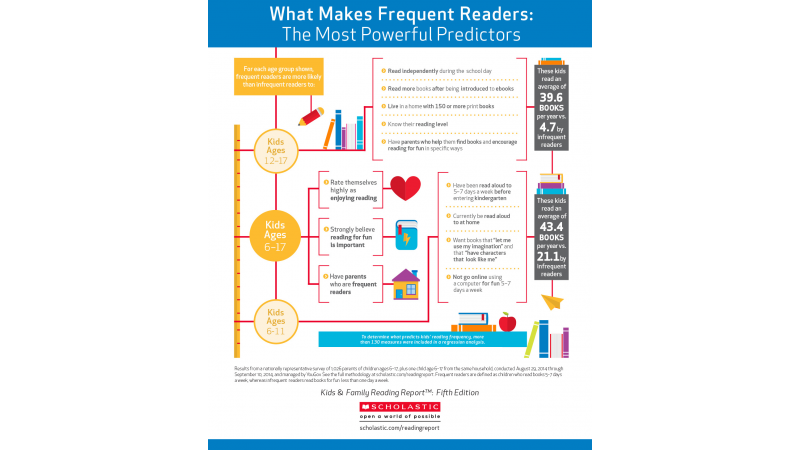
How often are kids reading books for fun? At what age do parents begin reading aloud to their children and when do they stop? Do kids have time for independent reading at school? And what is it, exactly, that kids are looking for in books? These are a few of the questions we set out to answer in the fifth edition of the Kids & Family Reading Report™, a biannual national survey of children ages 6–17 and their parents exploring their attitudes and behaviors around reading books for fun.
Released this morning (and already covered in this great New York Times piece!) the key data findings reveal several predictors of reading frequency, how frequently children have opportunities to read independently at school, and much more. This year’s survey also includes data from parents of children ages 0–5 to shed a light on the role parents play in children’s literacy development before they enter school and provide additional depth as we explored questions around reading aloud.
“Parents, teachers and librarians all want to help children develop into frequent readers, and the latest edition of theKids & Family Reading Report provides important insights on how a child’s reading experience can be guided both at home and at school to help develop a lifelong love of reading,” said Francie Alexander, Chief Academic Officer at Scholastic. “Our research shows that providing encouragement and time both in school and at home for children of all ages to enjoy books they choose to read will help them discover the power and joy of reading. These tactics will also help to motivate kids to read more books, which will improve their skills and open a world of possibilities for them in the future.”
Some highlights from the report:
- Frequent readers—defined as children who read books for fun 5–7 days a week—differ substantially in a number of ways from infrequent readers—those who read books for fun less than one day a week. (For example, among children ages 6–11, frequent readers read an average of 43.4 books per year, whereas infrequent readers read only 21.1. There’s an even more profound difference among frequent readers ages 12–17, who read 39.6 books annually, and infrequent readers, who read only 4.7.)
- What makes frequent readers? The Kids & Family Reading Report created two models for predicting children’s reading frequency—one each among kids ages 6–11 and 12–17—constructed through a regression analysis of more than 130 data measures from the survey. The findings are fascinating!
- Earlier this year, Scholastic announced its support of new guidelines from the American Academy of Pediatrics (AAP) recommending that parents begin reading to their children every day from the time they're born. KFRR findings showed that more than half of children ages 0–5 (54%) are read aloud to at home 5–7 days a week. This declines to only one in three kids ages 6–8 (34%) and to one in six kids ages 9–11 (17%); four in 10 children ages 6–11 who are no longer read books aloud at home (40%) say they wished their parents had continued reading aloud to them.
- Nearly three-quarters of parents with children ages 0–5 (73%) say they started reading aloud to their child before age one, but only 30% say they began before the age of three months.
- Six in 10 parents with children ages 0–5 (60%) have received advice that children should be read aloud to from birth; however, just under half of parents in the lowest-income households (47%) received this advice, versus 74% in the highest-income households.
- One-third of children ages 6–17 (33%) say their class has a designated time during the school day to read a book of their choice independently, but only 17% do this every or almost every school day.
- Half of children ages 6–17 who read independently as a class or school (52%) say it’s one of their favorite parts of the day or wish it would happen more often.
- Sixty-one percent of children ages 6–17 who live in the lowest-income households say they read books for fun mostly in school, or the same amount in school and at home, while only 32% of children ages 6–17 who live the highest-income homes say the same.
- The power of choice matters to kids! Ninety-one percent of kids ages 6–17 agree “my favorite books are the ones that I have picked out myself,” and you may remember from our December preview, 70% of kids want books that make them laugh.
- Print books remain the preferred format of books among kids but ereading is growing. 61% of kids ages 6–17 have now read an ebook, up from 46% in 2012, and we learned that among kids ages 12–17, reading more books after being introduced to ebooks is a predictor of reading frequency.
You can read the official press release here, and learn more about the data and download the full report here. Be sure to join the conversation online using #KFRR.



